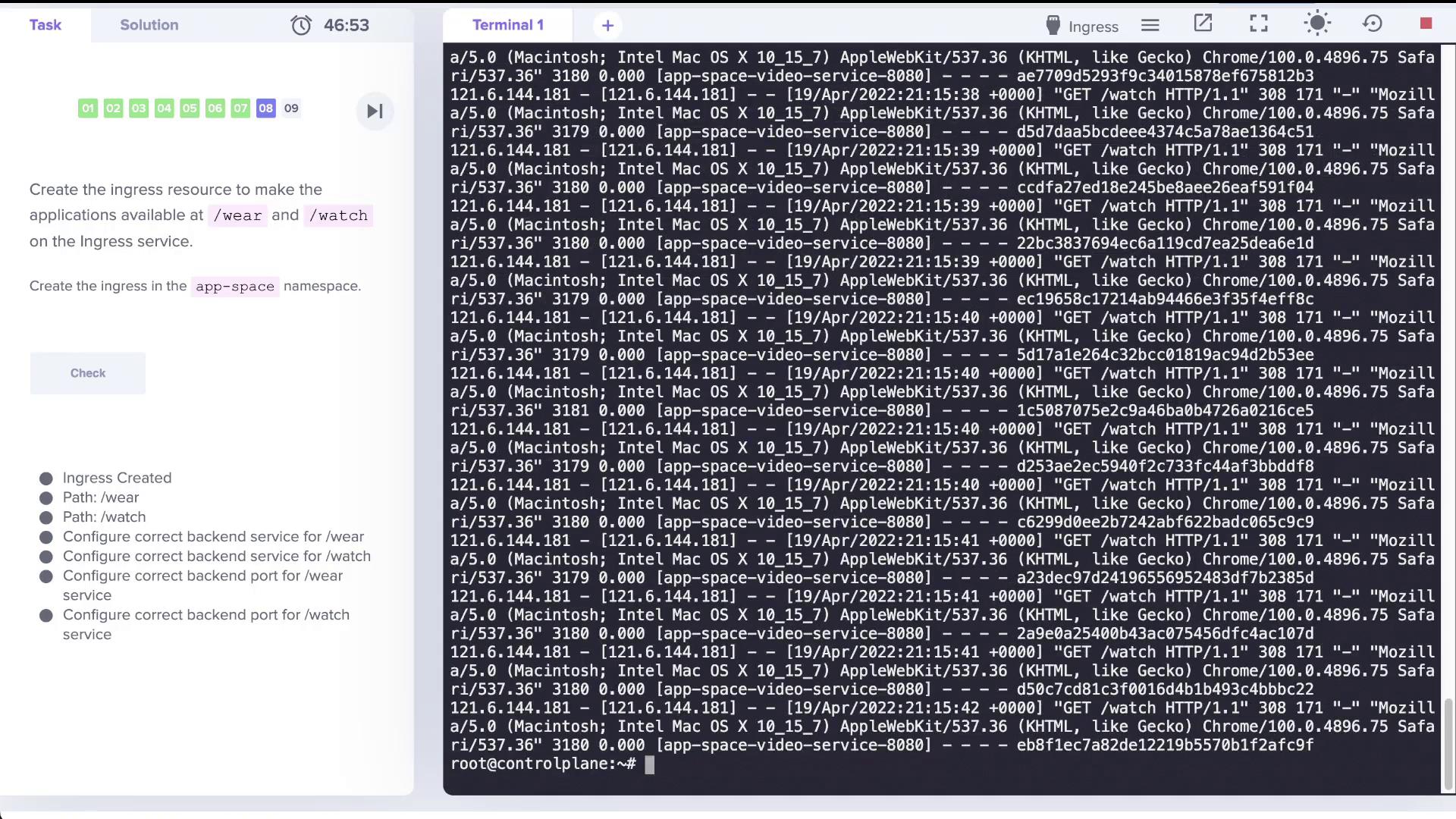CKA Certification Course - Certified Kubernetes Administrator
Networking
Solution Ingress Networking 2 optional
In this guide, we dive deeper into Ingress networking by deploying an Ingress controller and configuring traffic routing for your applications. We currently have two applications running in the "app-space" namespace: a video application and a wear application. Follow the steps below for a comprehensive setup and troubleshooting.
1. Verify the Existing Deployment
Before proceeding, ensure all your pods are running across all namespaces. Execute the command:
root@controlplane:~# kubectl get pod -A
NAMESPACE NAME READY STATUS RESTARTS AGE
app-space default-backend-5cf9fb9d-jqcp2 1/1 Running 0 50s
app-space webapp-video-486f855bd8-qpn5 1/1 Running 0 49s
app-space webapp-wear-6ff4945955-mmtqh 1/1 Running 0 20m
kube-system coredns-74ff55c5b-gffzq 1/1 Running 0 20m
kube-system etcd-controlplane 1/1 Running 0 20m
kube-system kube-apiserver-controlplane 1/1 Running 0 20m
kube-system kube-controller-manager-controlplane 1/1 Running 0 20m
kube-system kube-flannel-ds-ks7d7 1/1 Running 0 20m
kube-system kube-proxy-49z9b 1/1 Running 0 20m
kube-system kube-scheduler-controlplane 1/1 Running 0 20m
root@controlplane:~#
2. Setup: Ingress Namespace and Required Resources
a. Create the Ingress Namespace
Create a dedicated namespace for the Ingress controller:
root@controlplane:~# kubectl create namespace ingress-space
namespace/ingress-space created
b. Create a ConfigMap
The NGINX Ingress Controller requires a specific ConfigMap. Create it using the command below (replace the literal configuration with your actual settings if needed):
root@controlplane:~# kubectl create configmap nginx-configuration -n ingress-space --from-literal=key=value
c. Create a Service Account
Deploy a service account named ingress-serviceaccount in the ingress-space namespace:
root@controlplane:~# kubectl create serviceaccount ingress-serviceaccount -n ingress-space
d. Set Up Roles and RoleBindings
Assign the required roles to ensure proper permissions for the Ingress controller. Verify the roles:
root@controlplane:~# kubectl get roles -n ingress-space
NAME CREATED AT
ingress-role 2022-04-19T21:05:42Z
Inspect the role bindings:
root@controlplane:~# kubectl get rolebindings -n ingress-space
NAME ROLE AGE
ingress-role-binding Role/ingress-role 20s
For detailed role information, use:
root@controlplane:~# kubectl describe role ingress-role -n ingress-space
Name: ingress-role
Labels:
app.kubernetes.io/name=ingress-nginx
app.kubernetes.io/part-of=ingress-nginx
Annotations: <none>
PolicyRule:
Resources: [configmaps, endpoints, namespaces, pods, secrets]
Resource Names: (specific names if applicable, e.g., ingress-controller-leader-nginx)
Verbs: [get, create, update]
3. Deploy the NGINX Ingress Controller
Deploy the Ingress controller by creating a deployment in the ingress-space namespace. Use the YAML configuration below (ensure proper spacing and namespace specifications):
apiVersion: apps/v1
kind: Deployment
metadata:
name: ingress-controller
namespace: ingress-space
spec:
replicas: 1
selector:
matchLabels:
name: nginx-ingress
template:
metadata:
labels:
name: nginx-ingress
spec:
serviceAccountName: ingress-serviceaccount
containers:
- name: nginx-ingress-controller
image: quay.io/kubernetes-ingress-controller/nginx-ingress-controller:0.21.0
args:
- /nginx-ingress-controller
- --configmap=$(POD_NAMESPACE)/nginx-configuration
- --default-backend-service=$(POD_NAMESPACE)/default-http-backend
env:
- name: POD_NAME
valueFrom:
fieldRef:
fieldPath: metadata.name
- name: POD_NAMESPACE
valueFrom:
fieldRef:
fieldPath: metadata.namespace
ports:
- name: http
containerPort: 80
- name: https
containerPort: 443
Apply the deployment configuration:
root@controlplane:~# kubectl create -f ingress-controller.yaml
deployment.apps/ingress-controller created
Monitor the Ingress controller pods:
root@controlplane:~# kubectl get pods -n ingress-space --watch
NAME READY STATUS RESTARTS AGE
ingress-controller-5857685bf-qd8jz 0/1 ContainerCreating 0 16s
...
ingress-controller-5857685bf-qd8jz 1/1 Running 0 32s
4. Expose the Ingress Controller via a Service
To make the Ingress controller accessible externally, expose it using a NodePort.
Expose the deployment:
root@controlplane:~# kubectl expose deploy ingress-controller -n ingress-space --name ingress --port=80 --target-port=80 --type NodePort service/ingress exposedVerify the service details:
root@controlplane:~# kubectl get svc -n ingress-space NAME TYPE CLUSTER-IP EXTERNAL-IP PORT(S) AGE ingress NodePort 10.109.33.190 <none> 80:32741/TCP 9s
If you prefer a different NodePort (e.g., 30080 instead of the default allocation), edit the service:
root@controlplane:~# kubectl edit svc ingress -n ingress-space
Change the nodePort field under the port configuration to 30080 and save.
5. Create the Ingress Resource to Route Traffic
Now configure routing rules to forward traffic from specified paths to your applications located in the app-space namespace. In this example:
- Requests to
/wearroute to thewear-serviceon port 8080. - Requests to
/watchroute to thevideo-serviceon port 8080.
Create the Ingress resource with the following command:
root@controlplane:~# kubectl create ingress ingress-wear-watch -n app-space --rule="/wear=wear-service:8080" --rule="/watch=video-service:8080"
Verify the Ingress resource:
root@controlplane:~# kubectl get ingress -n app-space
NAME CLASS HOSTS ADDRESS PORTS AGE
ingress-wear-watch <none> * <none> 80 3m24s
6. Troubleshooting: Resolving Excessive Redirects
If you experience continuous HTTP 308 redirects when accessing the /watch path, inspect the Ingress controller logs:
root@controlplane:~# kubectl logs ingress-controller-5857685bf-qd8jz -n ingress-space
You might find lines similar to:
121.6.144.181 - [19/Apr/2022:21:15:38 +0000] "GET /watch HTTP/1.1" 308 171 "-" "Mozilla/5.0 ..." 3179 0.000 [app-space-video-service-8080]
These redirects are usually due to SSL redirection being enabled by default.
::: note "Note" To disable SSL redirection, update your Ingress resource with the following annotation: :::
Update your Ingress manifest to include the annotation:
apiVersion: networking.k8s.io/v1
kind: Ingress
metadata:
name: ingress-wear-watch
namespace: app-space
annotations:
nginx.ingress.kubernetes.io/ssl-redirect: "false"
spec:
rules:
- http:
paths:
- path: /wear
pathType: Exact
backend:
service:
name: wear-service
port:
number: 8080
- path: /watch
pathType: Exact
backend:
service:
name: video-service
port:
number: 8080
Apply the changes by editing the Ingress resource:
root@controlplane:~# kubectl edit ingress ingress-wear-watch -n app-space
After saving, retest your endpoints to confirm that the redirect issue is resolved.
7. Validate the Complete Setup
Ensure that the Ingress routes traffic correctly to your services:
Validate that the backend pods are running in the
app-spacenamespace:root@controlplane:~# kubectl get pods -n app-space NAME READY STATUS RESTARTS AGE default-backend-5cf9b7d-jqcp2 1/1 Running 0 12m webapp-video-84f865bd-qpbn5 1/1 Running 0 12m webapp-wear-6ff944955-mmtqh 1/1 Running 0 12mCheck the logs of the video and wear applications to ensure new requests are reaching them:
root@controlplane:~# kubectl logs webapp-video-84f865bd-qpbn5 -n app-spaceroot@controlplane:~# kubectl logs webapp-wear-6ff944955-mmtqh -n app-space
This confirms that your applications are functioning correctly on port 8080.
::: note "Additional Information" The terminal outputs and log details provided above help verify correct operation. The supplementary image below offers an additional illustration but is not required for successfully following these instructions. :::

Congratulations! You have successfully deployed an Ingress controller, exposed it via a NodePort service, configured the Ingress resource to route traffic to two distinct services, and resolved an SSL redirection issue.
Happy networking!
Watch Video
Watch video content